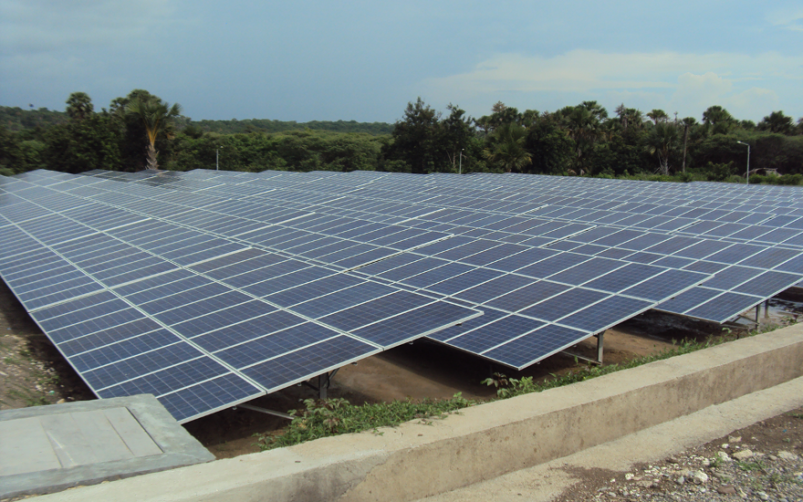Simulated Energy Production and Performance Ratio of 5 MW Grid-Connected Photovoltaic under Tropical Savannah Climate in Kupang Timor Island of Indonesia
Keywords:
grid-connected photovoltaic, tropical climate, energy production, performance ratio IEC 61724Abstract
The objective of this paper is to obtain energy output and performance ratio of 5 MW grid-connected PV plant. The plant is located near the city of Kupang in the southeast of Indonesia. The location belongs to dry tropical climate with 28o C average daily temperature and 67% and 87% average sunshine index during the rainy and hot season respectively. Daily solar irradiation varies from 5.52 to 6.38 kWh/m2. The plant uses 21,840 poly-crystalline 230 W modules configured as 1,040 array strings, and each array consists of 21 series-connected modules. The array is ground-mounted, fixed-tilted at 15o and facing north. Maximum output is 5,023.2 kW. Conversion to AC is done by 250-unit inverter of 20 kW. Grid connection is via 10-unit of 630 KVA transformers. PVSyst simulation is fed with synthetic meteorological data which yielded annual energy of 7,476 MWh that varies monthly from 526 to 770 MWh, with an average of 623 MWh. Average annual yields are 4.08 kWh/kWp/day. Variation of tilt angles from 10o to 20o has small effects on energy output. Monthly performance ratio varies from 80% to 86% and average at 82%. Low-performance ratio is shown during May to August period which is likely caused by the high ambient temperature that affects the output of the solar module. PV loss due to temperature is the highest losses component at 11.2%.
References
D. Siahaan, “Plan for grid solar PV development at small islands and integration of PV-diesel at east nusa tenggara province,” in Bali Clean Energy Forum, Bali, 2016.
LEN Indonesia, “Jokowi inaugurate the largest photovoltaic plant in Indonesia,” 27 December 2015. [Online]. Available: http://www.len.co.id/jokowi-resmikan-sistem-plts-terbesar-indonesia/. [Accessed 23 May 2016].
A. Mose, “Developing the first grid-connected solar PV in Indonesia,” in Bali Clean Energy Forum, Bali, 2016.
A. Aliya, “Jokowi inaugurate the largest photovoltaic plant in Indonesia,” 27 December 2015. [Online]. Available: http://finance.detik.com/read/2015/12/27/181336/3105036/1034/jokowi-resmikan-pembangkit-listrik-tenaga-surya-terbesar-di-indonesia. [Accessed 20 June 2016].
LEN Indonesia, “Datasheets of PV module LEN 230 polycrystalline,” LEN Indonesia, April 2010. [Online]. Available: http://www.len.co.id/len-230p-polycrystalline/. [Accessed 15 May 2016].
SMA Solar Technology AG, “Operating Manual - SUNNY TRIPOWER 20000TL / 25000TL,” SMA Solar Technology AG, 2004. [Online]. Available: http://files.sma.de/dl/24336/STP20-25TL-BE-en-12.pdf. [Accessed 15 May 2016].
G. M. Masters, Renewable and Efficient Electric Power Systems, Second ed., New Jersey: John Wiley & Sons, 2013.
M. C. Peel, B. L. Finlayson and T. A. McMahon, “Updated world map of the Koppen-Geiger climate classification,” Hydrology and Earth Systems Sciences, vol. 11, no. 5, pp. 1633-1644, 2007.
A. Zivan, “Indonesia map of Koppen climate classification: enhanced, modified and vectorized from World Koppen Classification by Peel at al,” 20 February 2016. [Online]. Available: https://commons.wikimedia.org/wiki/File:Indonesia_map_of_K%C3%B6ppen_climate_classification.svg. [Accessed 10 May 2016].
M. Mani and R. Pillai, “Impact of dust on solar photovoltaic (PV) performance: Research status, challenges, and recommendations,” Renewable and Sustainable Energy Reviews, vol. 14, no. 9, pp. 3124-3131, 2010.
S. Mekhiel, R. Saidur and M. Kamalisarvestani, “Effect of dust, humidity, and air velocity on efficiency of photovoltaic cells,” Renewable and Sustainable Energy Reviews, vol. 16, no. 5, pp. 2920-2925, 2012.
L. Arribas, G. Bopp, M. Vetter, A. Lippkau and K. Mauch, “Worldwide overview of design and simulation tools for PV hybrid systems,” IEA-PVPS, Waldweg, 2011.
PVSyst, “PVSyst Publications on meteo data comparisons,” PVSYst, 2016. [Online]. Available: http://www.pvsyst.com/en/publications/meteo-data-comparaisons. [Accessed 10 June 2016].
U. Jahn and W. Nasse, “Operational performance of grid-connected PV systems on buildings in Germany,” Progress in Photovoltaics Research Applications, vol. 12, no. 6, pp. 441-448, 2004.
A. Woyte, M. Richter, D. Moser, S. Mau, N. Reich and U. Jahn, “Monitoring of photovoltaic systems: good practices and systematic analysis,” Conf. & Exh. 28th European PV Solar Energy, Paris, 2013.
A. Hamzeh, S. Hamed, Z. Al-Qomari, A. Sandouk and G. Aldahim, “First year performance of a PV plant in Jordan compared to PV plants in the region,” International Journal of Renewable Energy Research, vol. 5, no. 4, pp. 983-990, 2015.
B. S. Kumar and K. Sudhakar, “Performance evaluation of 10 MW grid connected solar photovoltaic power plant in India,” Journal of Energy Reports, vol. 1, pp. 184-192, 2015.
A. M. Humada, M. Hojabari, H. M. Hamada, F. B. Samsuri and M. N. Ahmed, “Performance evaluation of two PV technologies (c-Si and CIS) for building integrated photovoltaic based on tropical climate condition A case study in Malaysia,” Energy and Buildings, pp. 233-241, 2016.
H. Patel and V. Agarwal, “MATLAB-based modeling to study the effects of partial shading on PV array characteristics,” IEEE Transactions on Energy Conversion, vol. 23, no. 1, pp. 302-310, 2008.
A. Pregelj, M. Begovic and A. Rohatgi, “Impact of inverter configuration on PV system reliability and energy production,” in Photovoltaic Specialists Conference, 2002. Conference Record of the Twenty-Ninth IEEE, New Orleans, 2002.
C. Huang, M. Eldesess, A. Bensoussan and K. L. Tsui, “Performance analysis of a grid-connected upgraded metallurgical grade silicon photovoltaic system,” MDPI Energies, 2016.
A. Zahedi and J. Hallenstain, “Effect of non-technical factors on the electricity cost of the photovoltaic (PV) systems,” International Conf. the Ninth Arab Solar Energy (AICSE-9), Bahrain, 2007.

Published
How to Cite
Issue
Section
License
Copyright (c) 2017 International Journal of Engineering and Technology Innovation

This work is licensed under a Creative Commons Attribution-NonCommercial 4.0 International License.
Copyright Notice
Submission of a manuscript implies: that the work described has not been published before that it is not under consideration for publication elsewhere; that if and when the manuscript is accepted for publication. Authors can retain copyright in their articles with no restrictions. Also, author can post the final, peer-reviewed manuscript version (postprint) to any repository or website.

Since Jan. 01, 2019, IJETI will publish new articles with Creative Commons Attribution Non-Commercial License, under Creative Commons Attribution Non-Commercial 4.0 International (CC BY-NC 4.0) License.
The Creative Commons Attribution Non-Commercial (CC-BY-NC) License permits use, distribution and reproduction in any medium, provided the original work is properly cited and is not used for commercial purposes.



.jpg)


